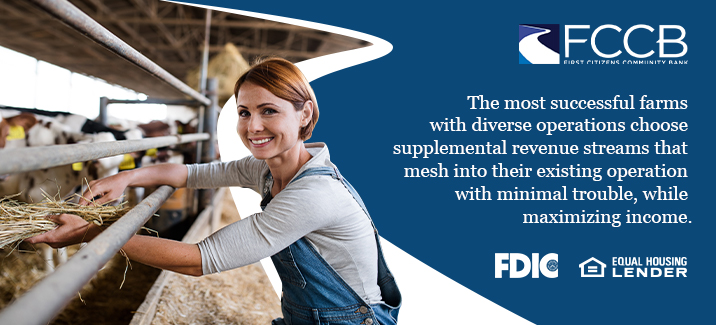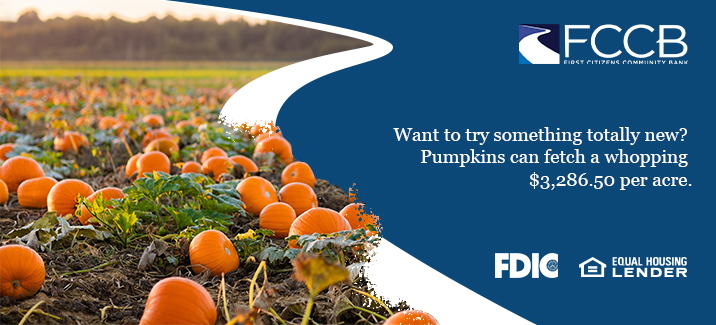What Ag Businesses Need to Know About Diversification
03/22/2022
Just like a financial advisor will tell you to put your money in a variety of accounts, stocks, and bonds in order to increase your earnings while reducing risk, the exact same principle can be applied to your agricultural business. Whether it’s adding a new, possibly higher-earning crop to your standard rotation, branching out into other forms of agriculture like animal husbandry, or using your farm property for novel revenue streams that take advantage of the land, structures, or scenery, there are many ways you can diversify your business, adding stability, profitability, and longevity to your operation.

Why Diversify Your Ag Business?
There are two major reasons to diversify your business: to protect your farm from income loss and to increase your profit margins. While crop yield and revenue insurance are essential tools for risk management, providing safeguards and a financial buffer should your bottom line take a hit, these policies only kick in after a certain threshold of loss (25% on average). Additional federal programs, like the Agricultural Risk Coverage (ARC) program and the Price Loss Coverage (PLC) program, designed to fill in the gaps for farmers, often only cover a portion of your acreage or yield. Most importantly, the specific purpose of these policies is to prevent catastrophic losses of income—they won’t increase your profits.
On the other hand, diversification of your business can. The most successful farms with diverse operations choose supplemental revenue streams that mesh into their existing operation with minimal trouble, while maximizing income.
How do you Diversify Your Ag Business?
There is no one-size-fits-all formula for farm diversification. The best options will not only vary widely from region to region, but farm to farm, as well. Before you jump into a new venture, you’ll need to consider which aspects of your farm operation are working well and which ones are expendable—those you could stand to lose or alter and those that are not sufficiently profitable. Also, consider the physical nature of your property, what spaces are underutilized, and where there is room for expansion or improvement.
Questions to ask Yourself:
As you begin to develop your business plan, the following list of questions can help you determine what might work best for you and your farm:
- How much acreage could I spare from my usual crop rotation?
- Important note: remember that any changes to acreage of commodity crops could affect your insurance policies.
- Are there any undeveloped areas of land that could be brought into the operation?
- Could the land or existing infrastructure be utilized for animal boarding or husbandry?
- What is the scenic value of the farm?
- Are there spaces conducive to hosting events (like weddings) or farm experiences (like pick-your-own patches)?
Once you’ve considered both the limitations and the potential of the farm, as well as your own interests, you will have a better idea of what new ventures will work well for your business.
Incorporate a New Crop into Your Standard Rotation
Adding a new crop to your usual rotation could be the simplest solution for your farm—though keep in mind there will likely be additional equipment costs and a learning curve to contend with. If you think this might work for your farm, there are two main routes you could take: utilize existing fallow times between harvests or offsetting some of your usual plantings with something new during your regular planting season.

Double-cropping and Intercropping
An important rule of thumb for double-cropping (adding another harvest per year on the same acreage) and intercropping (planting two crops in close proximity at the same time) is to choose a crop that will not further deplete the soil, thus reducing your other yields or increasing the cost of inputs.
Good possibilities for double-cropping include:
- Nitrogen-fixing forage: Either as a harvestable forage or for grazing purposes, planting a nitrogen-fixing forage between crops can not only improve soil but also add an additional stream of income on your already existing land. Allowing animals to graze directly on fields is healthier for the animals, reduces wintering costs by extending the grazing season, and has additional soil benefits not only from the plants, but the organic matter the animals themselves leave behind. The University of Kentucky provides this simple overview to help you get started in choosing the forage mix right for you. For forage you intend to harvest, you may need to commit tracts of land to more than the short gap between plantings. For instance, alfalfa is ideally grown for 1-2 years.
- Winter Wheat: Winter wheat can withstand cold temperatures up to -15 degrees fahrenheit, and according to SARE, is “less likely than barley or rye to become a weed and is easier to kill,” making it ideal for planting between regular harvests. Additionally, growing a grass crop with a fibrous root system like wheat over the winter months greatly reduces soil erosion, and the leftover leaves and straw after harvest can help build organic matter in the soil, while acting as weed suppressor. Successful Farmer offers some great information on the best planting options for double-cropping following wheat.
- Intercropping is another way to introduce an additional harvest to your regular growing season, while also having the potential to increase yield-per-acre of your usual crops. Instead of planting an entire field with the same crop, you plant two crops in strips, side-by-side. For example, intercropping corn and soy can result in more sunlight for the corn while maintaining soy yields. If you are interested in branching out beyond the usual soy-corn crop rotation, consider intercropping corn with forage like hairy vetch or grass pea, or interplanting wheat and soy.
Offset current plantings with something new
Maybe you have been growing the same crop or two for ages, are disappointed in current yields, or just want to try your hands at something new. You’ll want to start with small test plots before planting hundreds of acres of any new crop, and the USDA provides specific data on the production values of dozens of commodity crops in Pennsylvania. For instance, if you find your corn yields are down, switching to alfalfa can bring a similar profit per acre, while regenerating soil nutrients. Want to try something totally new? Pumpkins can fetch a whopping $3,286.50 per acre.
Work in the margins
If you aren’t ready to change up your current crop rotations, consider that many significant revenue streams (see pumpkins, above) don’t need a lot of land. High-profit specialty crops, including flowers, herbs, and specialty vegetables, can often be grown wherever you have land to spare. The USDA National Agricultural Library provides this extensive list of “alternative crops and enterprises” which also includes resources for farmers.

Consider Long-Term Agricultural Investments
Perennial Agriculture and Agroforestry
Perennial crops, including fruits, nuts, and hops, can yield some of the highest profits per acre once established. Orchards and other forms of perennial and forest agriculture can also add aesthetic interest to your farm, ideal for agritourism enterprises. But these crops are a long-term investment, often requiring years before initial expenses are recovered.
In their article “Before You Start an Apple Orchard,” the University of Minnesota puts it this way: “It's going to cost a lot of money to get started. There's really no other way to say it. Be sure you have the capital to purchase and operate an orchard before signing any agreement or sale contract.” Planting and maintenance in early years can be expensive and time-consuming, and testing out the best varieties before planting isn’t particularly conducive to crops that can take years to come into production, so it’s important to do your research up front and speak to your local extension office and financial institution if you are considering any larger-scale forms of perennial agriculture. Additionally, check out SARE’s Fruit and Nut Compass for farmers interested in diversifying their production, and if you’re curious about agroforestry, the Savanna Institute offers several free online courses to help you get started.
Animal Agriculture
For millennia, animals have been an integral part of farm operations. Although modern agriculture has often edged out their role, many farmsteads still have some of the necessary infrastructure needed for raising and boarding farm animals. Even if your existing farm setup doesn’t seem like it has a lot of potential, there may be an option that works for you.
Boarding
Horse boarding might be the first thing that comes to mind, but also consider that dog kennels may have more flexibility (for instance, you can choose not to accept boarders during harvest times), and lower start-up costs should you have the need to build the infrastructure from the ground up. Pre-existing stables or the funding to build new ones, and quality land that can be used for pasture, are essential for horse boarding. Before delving into either venture, do some research about the demand for these services in your area.
Dairy, Wool, and Eggs
While commercial dairy has taken a hit in recent years and starting a dairy operation from scratch is a major financial endeavor, specialty dairy like goat and sheep’s milk has remained a viable venture, with the possibility of starting small and scaling up. Sheep have the added benefit of producing wool, for additional revenue. If you’re looking to break into the market, consult PennState Extensions guide, “So You Want to Raise Sheep or Goats?” for an overview of considerations.
Selling eggs is an additional venture that can start small and be scaled up slowly. Eggs also make a great entry into sustainable agriculture. According to Bloomberg Business, sustainably-produced eggs, which sell for as much as $8 a dozen to local markets, are expected to rise to 70% of the market in the next five years.
Grazing Animals
We’ve mentioned adding forage into your crop rotations as a way to build soil and diversify your plantings. The flipside of this is adding animals which can graze on your forage. If you don’t want the added burden of raising your own animals, offering your land for grazing can provide income from other area farmers who wish to take advantage of the cost savings of extending grazing through the winter.
Agritourism
Everyone loves an idyllic farm setting, and many will pay good money for the experience. But Agritourism is not for every farmer—or every farm. Not every farm has the aesthetic qualities customers seek and not every region has the demand. Because agritourism is an entirely-different form of business than traditional agriculture—the hospitality business—researching the market and creating a viable business plan with professional assistance is essential before investing in a new agritourism enterprise.
The University of Vermont has created this thorough guide for creating a successful agritourism business, which includes methods for assessing your farm for its potential and details on business and financial planning.
Create a viable plan
Once you have determined potential areas of focus, you can begin working with your extension office and local lender to develop a business plan, determine your budget, and secure any necessary financing. Beginning Farmers also offers many resources for planning new enterprises, even for those with many years of farming experience.
Benefits Beyond the Bottom Line
Diversification can help stabilize income, provide new streams of revenue, and even improve overall farm health. Beyond these things, diversification can help strengthen your farm’s ties to the community, from inviting others to experience its beauty, to providing new opportunities to form relationships with other farmers and local customers and vendors.
While some new enterprises can be started with little overhead cost, many will require significant investment. Working with a community financial partner will ensure that you not only create a viable business plan, but also secure the funding to put your plan in action. First Citizens Community Bank offers a variety of agriculture and equipment loans, as well as many other financial products for small businesses. Reach out to our Agriculture Team to find out how we can help you successfully diversify your farm business!



